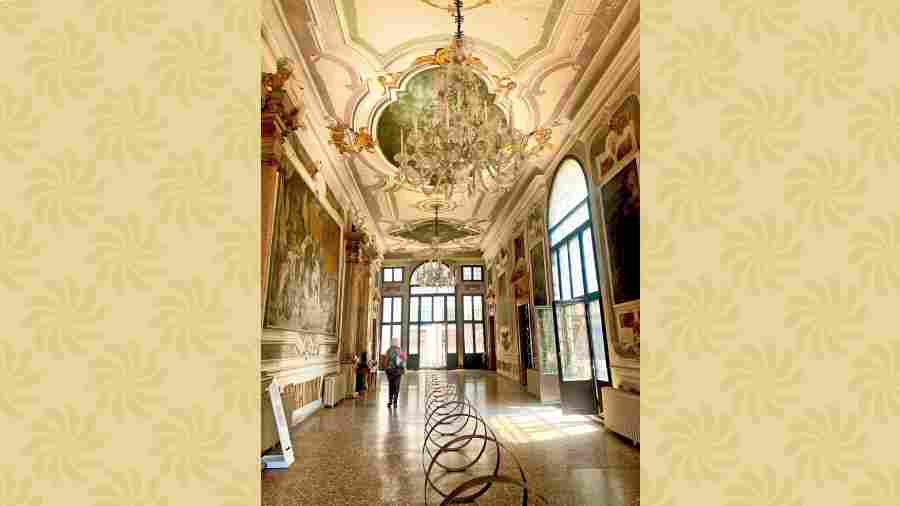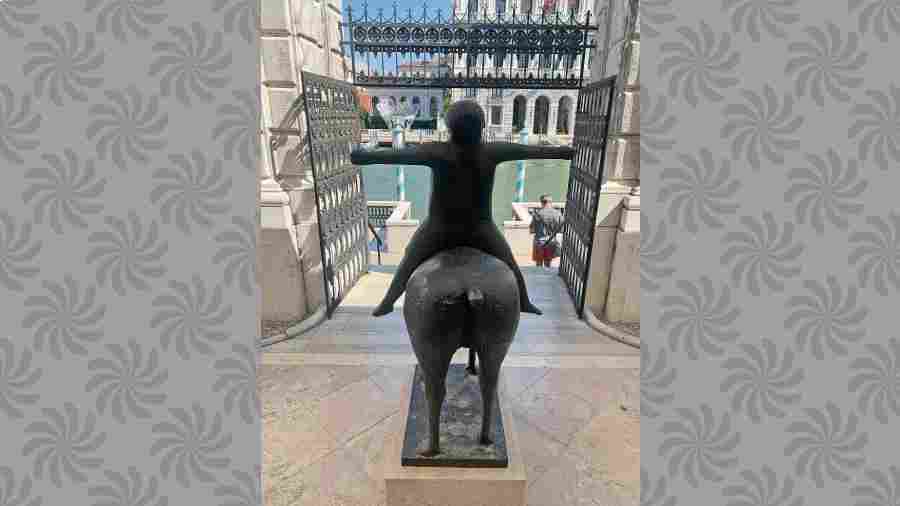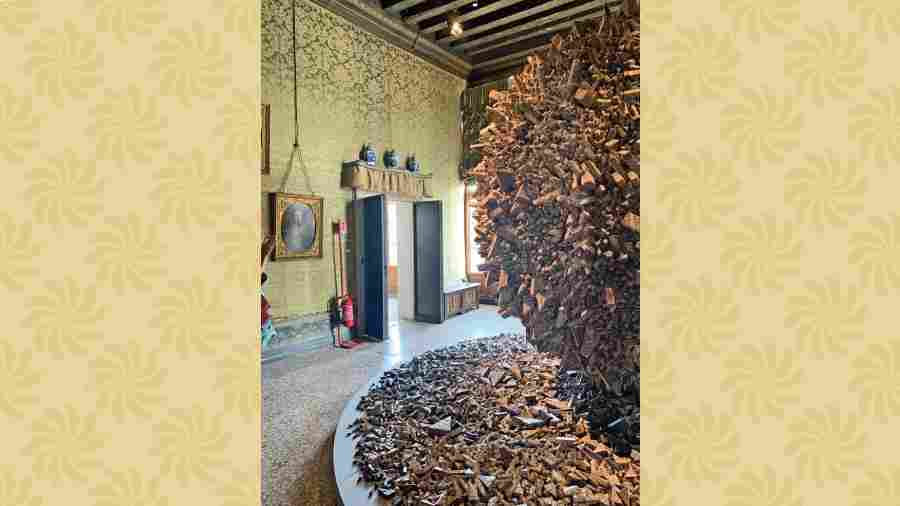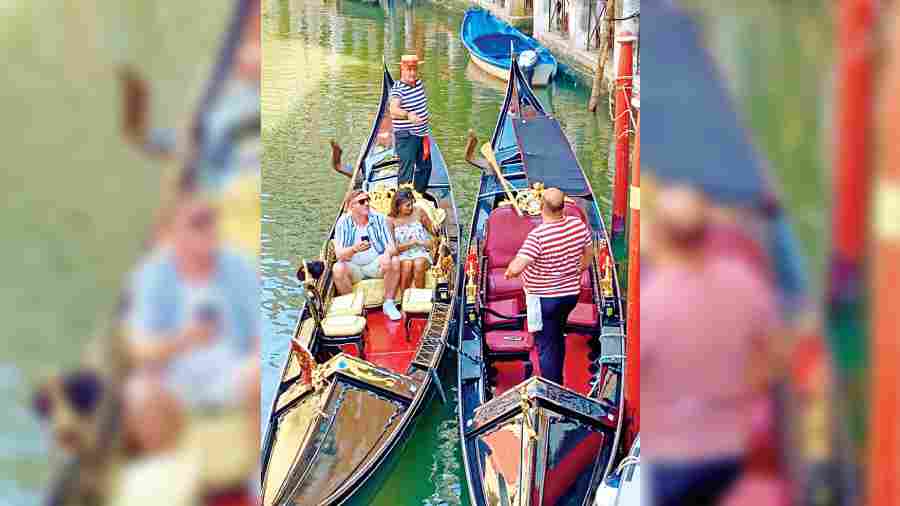People travel for all sorts of reasons — business, tourism, food, shopping and leisure. In recent years, themed tours have gained popularity and they throw together a group of people with a common goal, whether it’s golf, whisky, gardens or art. This is not a bad thing. It saves a person the agony of having to accompany a partner out of devotion not similar interests.
So this time in Venice (where I have the great fortune and privilege to return to year after year), I decided to devote a few days to discovering the famous Venice Biennale with a fellow art lover and local Venetian Elena Falchetti. What a treat! The Gardens or Giardini houses the main art exhibitions. This also has the Central Pavilion, built in 1894 and later restructured and extended several times and a further 29 pavilions built at different periods by the various countries participating in the Biennale. The first nation to build a pavilion was Belgium in 1907, followed by Germany, Britain and Hungary in 1909. The pavilions are the property of the individual countries and are managed by their ministries of culture.
Apart from the main art exhibitions in the Gardens and in Castello, in the halls of the Arsenale nearby, there are around 30 exhibitions hosted by the Biennale Foundation throughout Venice in its many stunning palazzi (palaces), ancient libraries and even churches. And although the entry ticket to the Main Gardens and Arsenale is reasonably priced, the exhibitions held elsewhere are completely free. In addition to the exhibitions which can be weird and wonderful, you also have access to 16th century palazzi which may not normally be open to the public, to their private art collections, interiors and amazing architecture, at close quarters. That’s the real privilege.

Treasures from the ‘Wreck of the Unbelievable’

A London group artist exhibition at the Music Conservatory
The Art Biennale (La Biennale d’Arte di Venezia) is one of the largest and most important contemporary visual art exhibitions in the world. So called because it is held biannually (in odd-numbered years), it is the original biennale on which others in the world have been modelled. The exhibition space spans over 7,000sq m and artists from over 75 countries are represented in the collective exhibition spaces as well as in the national pavilions. It is the hottest date on the international art calendar. Every two years the Venice Biennale transforms the city into a city of art, where the biggest names in the contemporary art world, internationally renowned galleries, curators and collectors rub shoulders with aspiring artists, art aficionados and those with an interest. Occurring on odd-numbered years since 1895, the International Art Exhibition of the Venice Biennale is one of the most anticipated events in the international cultural calendar. It starts in June till end November. This year it is in an even year because of the pandemic gap.
A little history
On April 19, 1893, the Venetian City Council passed a resolution to set up a biennial exhibition of Italian Art (“Esposizione biennale artistica nazionale”) to celebrate the silver anniversary of King Umberto I and Margherita of Savoy. A year later, the council decreed to adopt a ‘by invitation’ system; to reserve a section of the Exhibition for foreign artists too; to admit works by uninvited Italian artists, selected by a jury. The first Biennale was opened in 1895, by the Italian king and queen and was seen by 224,000 visitors. The event became increasingly international in the first decades of the 20th century. In 1910 the first internationally well-known artists were displayed: a room dedicated to Gustav Klimt, a one-man show for Renoir, a retrospective of Courbet. A work by Picasso, Family of Saltimbanques, was removed from the Spanish salon in the central Palazzo because it was feared that its novelty might shock the public. In 1920 the post of mayor of Venice and president of the Biennale was split. The new secretary general brought about the first presence of avant-garde art, notably Impressionists and Post-Impressionists. In 1930, the Biennale was transformed into an autonomous board and three entirely new events were established, including the Biennale Musica in 1930, also referred to as International Festival of Contemporary Music; the Venice Film Festival in 1932, which they claim as the first film festival in history and the Biennale Theatro in 1934, also referred to as International Theatre Festival. The film festival takes place in September and is a showstopper for glitz and glamour and a great mix of commercial and art cinema.
The Art Biennale was resumed in 1948 with a major exhibition of Impressionists and many protagonists of contemporary art including Chagall, Klee, Braque, Delvaux, Ensor, and Magritte, as well as a retrospective of Picasso’s work. Peggy Guggenheim’s participation in the 1948 Venice Biennale was a landmark event. Not only was it the first display of a comprehensive modern art collection in Italy after two decades of dictatorial regime, but also the first showing of her collection in Europe, following the end of the Second World War and her move to Venice from New York. At a time when the Italian Pavilion was dominated by Impressionism and Post-Impressionism, more than any other exhibition in that Biennale, her collection comprised the most contemporary art. This included Cubism, Futurism, abstraction, Surrealism, and, above all, Abstract Expressionism, the latest development of American art. It was the European debut of Jackson Pollock and the first appearance outside the US of a new generation of American painters, including William Baziotes, Mark Rothko and Clyfford Still. Peggy exhibited 136 works, many of which are now housed at Ca’ Venier dei Leoni, an 18th century palace which is now a museum in her name. In 1972, for the first time, a theme was adopted by the Biennale, called “Opera o comportamento” (“Work or Behaviour”).

Lorenzo Quinn ‘Support’ at Ca Sagredo Palazzo on the Grand Canal Venice Biennale 2017

Peggy Guggenheim Museum, Grand Canal Venice

Hung Kwang Young at the Palazzo Polignac
A contemporary art museum
The 2019 Biennale was titled ‘May You Live In Interesting Times’ and this year’s edition is called ‘The Milk of Dreams’ after a book by British-born Mexican surrealist painter Leonora Carrington. The Biennale today has an attendance of over 500,000 visitors. Countries not owning a pavilion in the Giardini are exhibited in other venues across Venice. The number of countries represented is still growing. In 2005, China was showing for the first time, followed by the African Pavilion and Mexico (2007), the UAE (2009), and India (2011).
For lovers of contemporary art, a visit to the Peggy Guggenheim Museum is an absolute must. Palazzo Grassi (an original 16th century palace rebuilt in the 18th century) and Punta della Dogana, which are now owned and curated by the Pinault Collection are the other two musts for cutting-edge contemporary art. In May 2005, the French industrialist billionaire François Pinault bought the Palazzo Grassi on the Grand Canal for 29 million euros. The remodelling of the building was assigned to the Japanese architect Tadao Ando. Two years later Pinault acquired the Punta della Dogana, Venice’s old customs buildings, which stand impressively on the tip where the Grand Canal meets the Giudecca Canal. It was transformed into a contemporary art museum paired with the Palazzo Grassi.
A few personal favourites
These are some of the most interesting exhibitions at the Biennale this year, thought provoking and which I personally visited and, most importantly, situated in the most stylish addresses in Venice… all on till end-November. If you are an Anish Kapoor fan, there is an ambitious presentation of both his retrospective and new works at the Gallerie dell’Accademia on the Grand Canal and at Palazzo Manfrin. This is the perfect opportunity to completely submerge yourself in art, inexpensively and without the hype, snobbism and mystery that the art world often surrounds itself with. I guarantee you won’t be disappointed.
Bosco Sodi a Palazzo Vendramin Grimani (What Goes Around Comes Around)
Bosco Sodi is renowned for his use of raw natural materials in large-scale sculptures and paintings. The essential simplicity of the material and the intense pigments, sought by Sodi from all over the world, form the basis of his creative process, which the artist described as a “controlled chaos” that produces “something completely unrepeatable”. The works are on the ground-floor hall of the palazzo overlooking the Grand Canal and forms the core of the exhibition.
In case you are interested: Palazzo Vendramin Grimani, San Polo 2033: info@fondazionealberodoro.org
Chun Kwang Young (Times Reimagined)
An aesthetic laboratory by Chun Kwang Young. His hanji (Korean mulberry paper) oriented reliefs, sculptures, installations, and, as a highlight, the site-specific architectural structure made in dialogue with architect Stefano Boeri are all being staged during the exhibition.
In case you are interested: Palazzo Contarini Polignac, Dorsoduro 874 (near the Accademia): timesreimagined@gmail.com
From Palestine With Art
The exhibition, promoted by the Palestine Museum US, shows the richness of contemporary art produced in Palestine and the diaspora.
In case you are interested: Palazzo Mora, Room 8, Cannaregio 3659: info@PalestineMuseum.US
Katharina Grosse (Apollo, Apollo)
In a black setting, Apollo, Apollo features a compositive image of Katharina Grosse’s hands printed on a metallic mesh fabric, depicting a moment where the boundaries between the artist’s body and the coloured material blur in the act of creating.
In case you are interested: Spazio Louis Vuitton, San Marco 1353, Calle del Ridotto: info_espace.it@louisvuitton.com (on the top floor of the store)
Kehinde Wiley (An Archaeology of Silence)
A reflection on the brutalities of American and global colonial pasts.
In case you are interested: Fondazione Giorgio Cini, Isola di San Giorgio Maggiore: kehindewileyvenezia@gmail.com
Uncombed, Unforeseen, Unconstrained
London introduces a group exhibition by 11 international contemporary artists, whose presentations align with the phenomenon of entropy, or a measure of disorder. Its collective history, threatening life on planet Earth.
In case you are interested: Conservatorio di Musica Benedetto Marcello, San Marco 2810: info@parasol-unit.org (the Music Conservatory of Venice is definitely worth the visit)
Karen Anand is a culinary consultant, food writer and entrepreneur. In recent times her name has been synonymous with farmers’ markets. Follow her on www.facebook.com/karenanand and on Instagram @karen_anand
